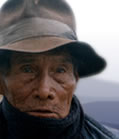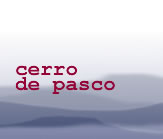THEMES IN THIS
TESTIMONY
Compensation

Conflict

Education

Environment

Gender

Health

Industry

Land

Migration

Spiritual Beliefs

Click on arrows
to find more
testimonies
featuring
these themes
|
|
Sex
|
female
|
|
|
Age
|
38
|
|
|
Occupation
|
municipal worker
|
|
|
Location
|
Quiulacocha
|
|
|
Date
|
1995
|
|
summary
Luzmila was born in Yauli and moved to Quiulacocha when her husband's company moved him to Cerro de Pasco. Having lived previously in mining camps, she is able to contrast the lifestyle and customs there to that of the campesino communities, including attitudes to education, and to men and women.
She discusses the lack of prospects in the mines and the occupational and health problems faced by the campesinos due to the pollution, both of which are leading to migration of young people from the community.
She also discusses the organisation of the community and the conflict between the indigenous community institutions and the state institutions. At times the community has been involved in joint actions with neighbouring communities, in their fight against the mining company and contamination.
She talks about the developments the mining company has brought for them including a new park and a milk shed. However she puts this in context, citing the problems the mining has caused in terms of contamination, illness, accidents and conflict - “Illnesses, accidents, for the workers deaths....I don't think things are better in our village.” More positively she talks about the different ways the community is trying to move ahead. The interview ends with some questions on stories, myths, legends etc. but she claims that older people would know more about those things.
detailed breakdown
|
You will need a password from Panos to view the full
transcript of the interview. To apply for a password, click here.
Once you have a password, click here to go to the beginning
of the transcript. You can also click on any section of the
breakdown of content below and go straight to the
corresponding part of the transcript.
|
| Section 1 |
After marriage she moved to husband's community and the mining company moved them to Cerro de Pasco. Marriages between mining families are frequent.
|
| Section 2 |
Many friends moved to Lima and people rarely return having left community except to visit.
Life of miners has not changed. There is no alternative to working in the mines.
Miners retire away from camps.
|
| Section 2-3 |
Miners being laid off because of privatisation
|
| Section 3 |
Differences between life in mining camps and in villages: for example, there's communal work and more activities for women [in campesino communities].
Husband is comunero (registered community member with rights and responsibilities) while she's a member of cooperative.
|
| Section 4 |
Education of children – people are less bothered in rural community than in mining company. Male education is given priority but this is changing. Girls drop out of school when they get married or “pair up”. |
| Section 5 |
Local livelihoods: cattle rearing has become a poor business because the grass is poor, other work includes extracting sand/limestone.
Used to grow maca (small tuber like a radish) but the belief that good harvest led to strange deaths meant they stopped growing crop.
Husband died in mining accident
|
| Section 6 |
Details of husband’s accidents, also of mining-related illnesses from mines
Change in community organisation with presence of municipio (village council) - arm of central government. Other institutions in Quiulacocha
|
| Section 7 |
Community organisation is autonomous and people from community respect this more than the municipio (local council). The municipio has at times made decisions without consulting them - not accountable.
Joint action of organisations in community (community, cooperative, municipio) against mining
|
| Section 7-8 |
Effects of contamination - stomach problems, decaying teeth, loss of hair, lack of good grass, death of animals etc.
|
| Section 8 |
More on joint actions - digging channels to divert waste waters away from community; stopped company machines from passing. Violent interference of military in these actions.
Problems with Centromin going on since 1970/72 - says haven't achieved much as a result of legal trials.
|
| Section 9 |
Centromin offered to build park/ milk shed but community not pleased as this doesn't solve problems of pollution and contamination.
Talks about company's proposals to relocate community - mining companies swallowing up all the land but people don't want to leave without adequate compensation
|
| Section 10 |
Used to fish in the lakes but can't now because of pollution; mining company installed drinking water as compensation - only other "developments" include illnesses, accidents, deaths, pollution and conflicts
|
| Section 11 |
Talks about what they're doing to overcome problems - develop livestock, trading meat, wool industry, bakery, clothing workshop, milk programme
|
| Section 12 |
Plans for weaving training.
Current situation of Quiulacocha quite peaceful - people have a few options. Previously had problems with thieves.
The cooperative is what will help people develop if army and police don’t interfere.
|
| Section 13 |
There is a Military base in Quilacocha to protect company: some terrorism in past.
Talks about culture - didn't know any songs or stories but said they paid a singer to record a song about pollution but no one came to do it. Also trying to record the history of community which she thinks is important
|
|


